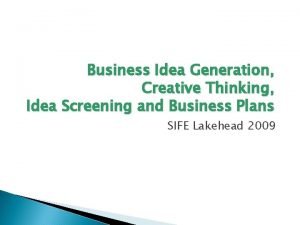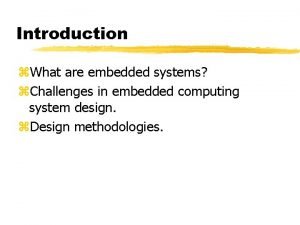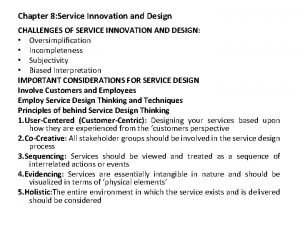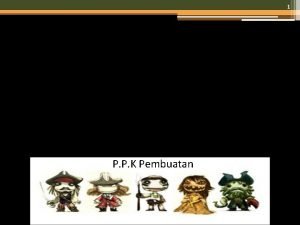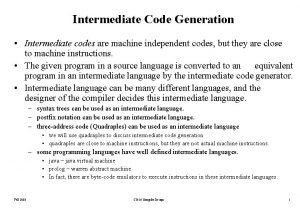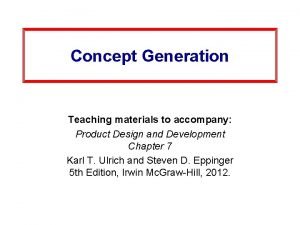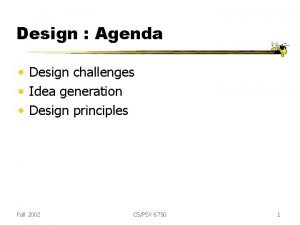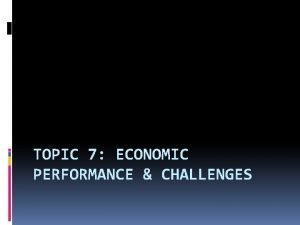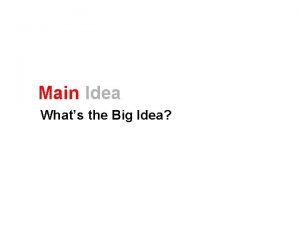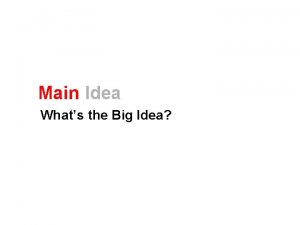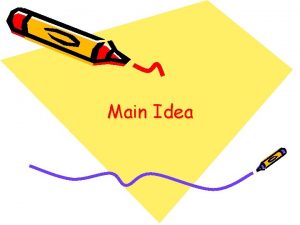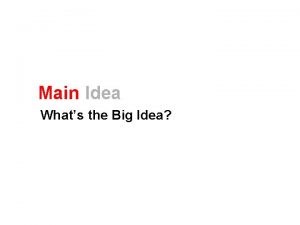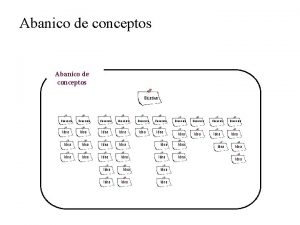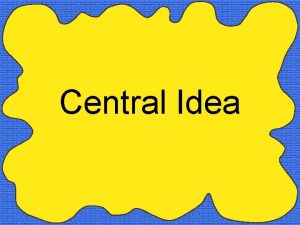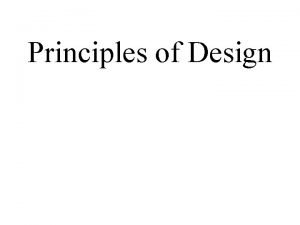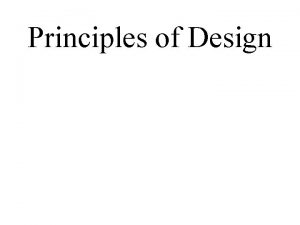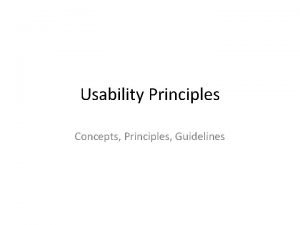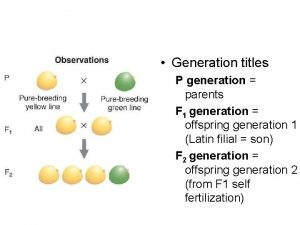Design Agenda Design challenges Idea generation Design principles






























- Slides: 30

Design : Agenda • Design challenges • Idea generation • Design principles Fall 2002 CS/PSY 6750 1

Design dilbert Fall 2002 CS/PSY 6750 2

System-Centered Design • Focus is on the technology - What can be built easily using the available tools on this particular platform? - What is interesting to me, as the developer, to build? Fall 2002 CS/PSY 6750 3

User-Centered Design • Design is based on user’s - Tasks - Abilities - Needs - Context • Mantra: Know the user! Fall 2002 CS/PSY 6750 4

Guidelines for Design • 1. Provide a good conceptual model - User has mental model of how things work - Build design that allows user to predict effects of actions • 2. Make things visible - Visible affordances, mappings, constraints - Remind person of what can be done and how to do it Fall 2002 CS/PSY 6750 5

Why is Design Difficult? • 1. Increasing complexity/pressure - Number of things to control has risen dramatically - Display is increasingly symbolic/artificial - Feedback is more complex and subtle - Errors are increasingly serious/costly Fall 2002 CS/PSY 6750 6

Why Difficult? • 2. Marketplace pressures - Time is money - Adding functionality (complexity) is now easy and cheap - Adding controls/feedback is expensive - Design usually requires several iterations before success Fall 2002 CS/PSY 6750 7

Why Difficult? • 3. People often consider cost and appearance over human factors design - Style over substance - Bad design may not be visible Fall 2002 CS/PSY 6750 8

Why Difficult? • 4. Creativity is challenging - Can’t just make a copy - Want creativity, but want pragmatism Fall 2002 CS/PSY 6750 9

Idea Creation How do we create and develop new interface ideas and designs? • Ideas come from - Imagination - Analogy - Observation of current practice - Observation of current systems Fall 2002 • Borrow from other fields CS/PSY 6750 - Animation Theatre Information displays Architecture. . . 10

Interface Metaphors • Metaphor - Application of name or descriptive term to another object which is not literally applicable - Use: Natural transfer - apply existing knowledge to new, abstract tasks - Problem: May introduce incorrect mental model Fall 2002 CS/PSY 6750 11

Metaphor Creation (1) • Prepare - What functions are needed - What are users’ problems? Fall 2002 CS/PSY 6750 12

Metaphor Creation (2) • Generate - Use metaphor that matches users’ conceptual tasks - Given choice, choose metaphor closest to way system really works - Ensure emotional tone is appropriate to users Fall 2002 CS/PSY 6750 13

Metaphor Creation (3) • Evaluate • Evolve Fall 2002 CS/PSY 6750 14

Idea Creation • Other methods for creating and developing interface ideas -? Fall 2002 CS/PSY 6750 15

Idea Creation Methods • 1. Consider new use for object • 2. Adapt object to be like something else • 3. Modify object for a new purpose Fall 2002 CS/PSY 6750 16

Idea Creation Methods • 4. Magnify - add to object • 5. Minimize - subtract from object • 6. Substitute something similar Fall 2002 CS/PSY 6750 17

Idea Creation Methods • 7. Rearrange aspects of object • 8. Change the point of view • 9. Combine data into an ensemble Fall 2002 CS/PSY 6750 18

Design Guidelines/Principles • General guidelines (advice) to help create more usable systems & • Can be subtle, even contradictory Fall 2002 CS/PSY 6750 19

Design Principles • 1. Use simple and natural dialog in user’s language - Match user’s task in a natural way - Avoid jargon, techno-speak Insufficient funds to withdraw $100 VS. X. 25 connection discarded due to network congestion. Local limits now in effect - Present exactly info that user needs Less is more! Fewer unnecessary windows, prompts, dialogs Fall 2002 CS/PSY 6750 20

Fun Examples Fall 2002 CS/PSY 6750 21

Design Principles • 2. Strive for consistency - Sequences, actions, commands, layout, terminology - Makes more predictable OK Cancel Help Done Cancel Apply Fall 2002 CS/PSY 6750 22

Design Principles • 3. Provide informative feedback - Continuously inform user about what is occurring - Most important on frequent, substantive actions - How to deal with delays? Fall 2002 CS/PSY 6750 23

Design Principles • 4. Minimize user’s memory load - Recognition is better than recall - Describe required input format, include example and default Date _ _ - _ _ (DD-Mmm-YY, e. g. , 02 -Aug-93) - Use small # of generally applicable commands Fall 2002 CS/PSY 6750 24

Design Principles • 5. Permit easy reversal of actions - Undo! - Reduces anxiety, encourages experimentation Fall 2002 CS/PSY 6750 25

Design Principles • 6. Provide clearly marked exits - Don’t want the user to feel trapped - Examples Cancel button on dialogs Interrupt/resume on lengthy operations (modeless) Quit - can exit anytime Reset/defaults - restore on a property sheet Fall 2002 CS/PSY 6750 26

Design Principles • 7. Provide shortcuts - Enable frequent users to perform often-used operations quickly Keyboard & mouse - abbreviations - menu shortcuts - function keys - command completion - double click vs. menu selection Navigation between windows/forms Reuse Provide history system Fall 2002 CS/PSY 6750 27

Design Principles • 8. Support internal locus of control - Put user in charge, not computer - Can be major source of anxiety Enter next command vs. Ready for next command Fall 2002 CS/PSY 6750 28

Design Principles • 9. Handle errors smoothly and positively • 10. Provide useful help and documentation - (More to come later in course on these two) Fall 2002 CS/PSY 6750 29

Good & Bad Designs • www. baddesigns. com • www. iarchitect. com Fall 2002 CS/PSY 6750 30
 Next generation learning challenges
Next generation learning challenges First generation antipsychotics vs second
First generation antipsychotics vs second God you are good and your mercy endureth forever
God you are good and your mercy endureth forever Agenda sistemica y agenda institucional
Agenda sistemica y agenda institucional Contoh idea generation
Contoh idea generation What is gordon method
What is gordon method New product development essay
New product development essay Problem inventory analysis
Problem inventory analysis Inside out idea generation
Inside out idea generation What does central idea mean
What does central idea mean Expository preaching vs. exegetical preaching
Expository preaching vs. exegetical preaching Suporting idea
Suporting idea Theme and topic difference
Theme and topic difference What is irrelevant sentences
What is irrelevant sentences What is the implied main idea of the passage?
What is the implied main idea of the passage? Wacana penulisan ipg
Wacana penulisan ipg Major principles of idea
Major principles of idea Challenges in embedded system design
Challenges in embedded system design Challenges of service innovation and design
Challenges of service innovation and design Design metrics in embedded system
Design metrics in embedded system Basic challenges of organizational design
Basic challenges of organizational design Concept generation in product design
Concept generation in product design Intermediate code example
Intermediate code example Generate product concepts
Generate product concepts Agenda design ideas
Agenda design ideas Interior design lecture notes+ppt
Interior design lecture notes+ppt What challenges did madison face abroad
What challenges did madison face abroad Toward civil war lesson 3 secession and war
Toward civil war lesson 3 secession and war Topic 7 economic performance and challenges
Topic 7 economic performance and challenges Netflix kids 2015
Netflix kids 2015 Challenges of being a disciple in the modern world
Challenges of being a disciple in the modern world







